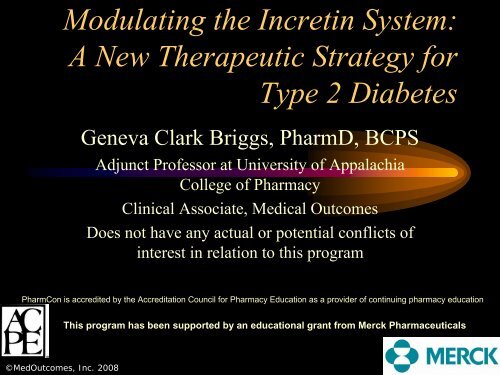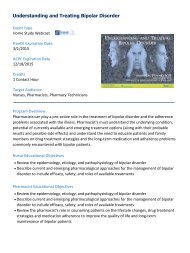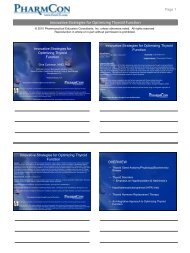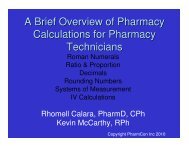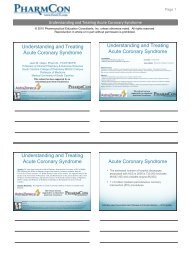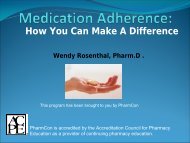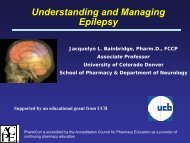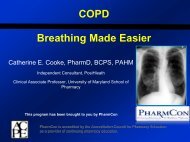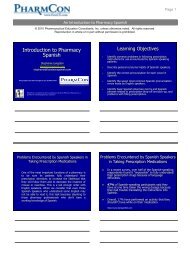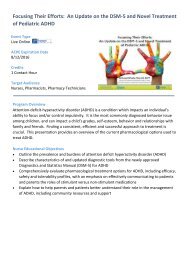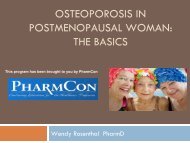A New Therapeutic Strategy for Type 2 Diabetes - Free CE ...
A New Therapeutic Strategy for Type 2 Diabetes - Free CE ...
A New Therapeutic Strategy for Type 2 Diabetes - Free CE ...
Create successful ePaper yourself
Turn your PDF publications into a flip-book with our unique Google optimized e-Paper software.
Modulating the Incretin System:A <strong>New</strong> <strong>Therapeutic</strong> <strong>Strategy</strong> <strong>for</strong><strong>Type</strong> 2 <strong>Diabetes</strong>Geneva Clark Briggs, PharmD, BCPSAdjunct Professor at University of AppalachiaCollege of PharmacyClinical Associate, Medical OutcomesDoes not have any actual or potential conflicts ofinterest in relation to this programPharmCon is accredited by the Accreditation Council <strong>for</strong> Pharmacy Education as a provider of continuing pharmacy educationThis program has been supported by an educational grant from Merck Pharmaceuticals©MedOutcomes, Inc. 2008
Overview• Underlying defects with <strong>Type</strong> 2 diabetes• Importance of managing postprandialglucose control• Incretin Hormones– <strong>New</strong> therapies that target incretin hormones©MedOutcomes, Inc. 2008
The <strong>Diabetes</strong> Epidemic• 8.0% of US childrenand adults havediabetes.• 57 million have prediabetes• 1.6 million new casesdiagnosed in peopleaged 20 years or olderin 2007.• 90-95% <strong>Type</strong> 2©MedOutcomes, Inc. 20085.7millionundiagnosed17.9milliondiagnosedNational <strong>Diabetes</strong> Statistics Fact Sheet. 2008.JAMA 2007;297:2716-2724.
Normal Glucose HomeostasisFastingStateGlucagon(alpha cell)PancreasInsulin(beta cell)Glucose outputLiverBlood glucoseGlucose uptakeMuscleAdiposetissueClin Invest Med. 1995;18:247–254.Joslin’s <strong>Diabetes</strong> Mellitus. 14th ed. Lippincott Williams & Wilkins; 2005:145–168.
Normal Glucose HomeostasisGlucagon(alpha cell)PancreasFed stateInsulin(beta cell)Glucose outputLiverBlood glucoseGlucose uptakeMuscleAdiposetissueClin Invest Med. 1995;18:247–254.Joslin’s <strong>Diabetes</strong> Mellitus. 14th ed. Lippincott Williams & Wilkins; 2005:145–168.
Case Study• Susan is 47-year-old Native American woman whosigns up <strong>for</strong> glucose screening in your pharmacy.• Medical History: gestational diabetes 13 yrs ago withonly child, hypertension• Medications: HCTZ 25 mg qd• Family History: 62-year-old father developed type 2diabetes at age 50• Fasting glucose = 105 mg/dl• HT: 5'6”, WT: 188 lbs (BMI: 30.3)• BP: 142/86 mm Hg©MedOutcomes, Inc. 2008
Natural History of <strong>Type</strong> 2 <strong>Diabetes</strong>Prediabetes/IGT/IFGT2DMPostprandial glucoseGlucoseFasting glucose126 mg/dl-10 -5 0 5 10 15 20 25 30RelativeFunction100%Insulin levelBeta-cell functionInsulin resistance —hepatic and peripheral–10 –5 0 5 10 15 20 25 30Years from <strong>Diabetes</strong> DiagnosisIGT=impaired glucose tolerance; IFG=impaired fasting glucose.<strong>Diabetes</strong> Care 1992;15:815-819.
Major Pathophysiologic DefectsGlucagon(alpha cell)Islet-cell dysfunctionPancreasLiverHepaticglucoseoutputInsulin(beta cell)HyperglycemiaInsulinresistanceGlucose uptakeMuscleAdiposetissueJoslin’s <strong>Diabetes</strong> Mellitus. 14th ed. 2005:145–168.Horm Metab Res. 2004;36:775–781. Clin Invest Med. 1995;18:247–254.
Other fundamental defects in<strong>Type</strong> 2 diabetes• Accelerated gastric emptying• Impaired meal-stimulated insulin release(deficient amylin and GLP-1 secretion)©MedOutcomes, Inc. 2008
Gastric Emptying RatesJ Nucl Med. 1992;33(8):1496-1500©MedOutcomes, Inc. 2008
Unmet Pathophysiologic Needs in <strong>Type</strong>2 <strong>Diabetes</strong> Mellitus• Progressive loss of beta-cell function and mass• Inappropriate glucagon secretion• Uncontrolled postprandial hyperglycemia• Possible impaired satiety signals resulting inweight gain• Accelerated gastric emptying• Deficient incretin effect©MedOutcomes, Inc. 2008
Current Treatment GuidelinesBiochemical IndexFasting/preprandialplasma glucose(mg/dl)Postprandialplasma glucose(mg/dl)Normal ADAGoalA<strong>CE</strong>/AA<strong>CE</strong>Goal< 100 70-130 < 110
Recent Trials in <strong>Type</strong> 2 DM• ACCORD©MedOutcomes, Inc. 2008– median 8 yrs ofdisease, target A1C
What is A1C and Why is itImportant?• Glycated or glycosylated hemoglobin– HbA1C, A1C• Normal range: 4.0% to 6.7%• Reflects mean glucose levels over preceding120 days• Elevated in: Uncontrolled diabetes mellitus,lead toxicity, alcoholism, iron deficiencyanemia, hypertriglyceridemia©MedOutcomes, Inc. 2008
Mean Plasma GlucoseA1C (%) Mean plasma glucosemg/dl mmol/l6 135 7.57 170 9.58 205 11.59 240 13.510 275 15.511 310 17.5<strong>Diabetes</strong> Care 2008;31:S12-S54
GOOD GLY<strong>CE</strong>MIC CONTROL:• Each 1% reduction in mean A1CA CRITICAL GOAL– Reduces risk of death from diabetes by 21%– Reduces risk of microvascular complications by37%A1C Goal Achievement36%64%> 7%< 7%UKPDS 35 BMJ 2000:321:405-412©MedOutcomes, Inc. 2008
GOOD GLY<strong>CE</strong>MIC CONTROL: ACRITICAL BUT ELUSIVE GOALMultiple factors continue to challenge goalachievement.– natural progression of beta-cell dysfunctionwith increasing hyperglycemia– Poor adherence to prescribed therapy– Uncontrolled post-prandial glucose– Poor adherence to prescribed therapy– Uncontrolled post-prandial glucose©MedOutcomes, Inc. 2008
Increasing Contribution of PPGas A1C Improves120100% Contribution806040200703060 55 5040 45 503070FPGPPG>10.2 10.2-9.3 9.2-8.5 8.4-7.3
Patients With <strong>Type</strong> 2 <strong>Diabetes</strong> May Spend 12Hours per Day in the Postprandial StateDuration of Postprandial StatePostprandialPostabsorptiveFastingBreakfast Lunch Dinner Midnight 4 AM Breakfast8 AM 11 AM 2 PM 5 PMTimes of blood sampling to obtaina diurnal blood glucose profile©MedOutcomes, Inc. 2008Eur J Clin Invest. 2000;30(suppl 2):3-11.
Importance of PostprandialHyperglycemia• IGT is a risk factor <strong>for</strong> cardiovasculardisease• Contributes more to A1C than FPG at A1Cs< 7.3%• Can be rate limiting factor <strong>for</strong> achievingadequate glycemic controlDiabetolgia 2002;45:1224-1230<strong>Diabetes</strong> Care 1999;22:920-924©MedOutcomes, Inc. 2008
Incretin Hormones• Peptides produced by GI tract in response tofood• Influence post-prandial insulin release(insulinotropic)• Glucagon-like peptide-1 (GLP-1)• Gastric inhibitory polypeptide (GIP)©MedOutcomes, Inc. 2008
The Incretin Effect – Beta CellResponse to Oral GlucoseJ Clin Endocrinol Metab. 1996:82:492-498.
GLP-1 Actions in HumansUpon ingestion of foodGLP-1 is secreted fromthe L cells in the intestine•Stimulates glucosedependent insulinsecretion•Suppresses glucagonsecretion•Slows gastric emptying•Reduces food intake•Improves insulinsensitivity©MedOutcomes, Inc. 2008Long term effects (in animals)•Increases beta cell mass andmaintains beta-cell efficiency
Postprandial GLP-1 LevelsNGT = normal glucose toleranceIGT = impaired glucose toleranceT2DM = type 2 diabetes mellitusJ Clin Endocrinol Metab. 2001;86(8):3853-60.
Incretin-Based Therapies• Incretin Mimetics (GLP-1 agonists/analogs)– Exenatide (Byetta)– Others: Liraglutide, LY307161 SR, CJC-1131, ZP10,BIM51077• Incretin Enhancers (DPP-IV inhibitors)– Sitagliptin– Vildagliptin– Others: saxagliptin©MedOutcomes, Inc. 2008
Exenatide (Byetta ® )• Binds to GLP-1 receptor• T1/2 ~ 2.5 hrs• Given as 5 – 10 mcg SC within 1 hr be<strong>for</strong>emorning and evening meal• Indicated <strong>for</strong> type 2 patients not controlled onmet<strong>for</strong>min, sulfonylurea, TZD, or combination• Long acting <strong>for</strong>mulation under development©MedOutcomes, Inc. 2008
Exenatide (Byetta ® )What to Do About Nausea?• Adverse effects– Nausea (50%), diarrhea, dyspepsia, pancreatitis(rare)• Tends to improve over time• May be less severe if exenatide is givencloser to a meal• Low-fat diet and eating slowly seem to help• Remind patient to stop eating when full©MedOutcomes, Inc. 2008
Exenatide 3 year A1C DataPBO-ControlledOpen-Label Uncontrolled1098-1.1 ± 0.1%Baseline A1C8.2%-1.0 ± 0.1%A1C (%)76554% % achieving A1C ≤7%40 26 52 78 104 130 156Time (wk)N = 217Buse JB, et al. Presented at ADA, 67th Scientific Sessions; 2007; Chicago, IL (abstract 0283-OR)46%
Improvement in HOMA-BFrom Baseline Through 3 YearsP
Exenatide• Advantages– Does not caused hypoglycemia unless combined with unadjusteddoses of other hypoglycemics– Weight loss of ~ 4-6 lbs over 6 months, > 10 lbs over 2 years– Decreases A1C by 0.5-1%– Longer term A1C, weight, and HOMA-B data• Disadvantages– ADE: diarrhea, dyspepsia, nausea, vomiting– Injection administration only– Administer within 60 minutes be<strong>for</strong>e meals– Concurrent use with insulin, meglitinides, orα-glucosidase is not well studied©MedOutcomes, Inc. 2008
Sitagliptin (Januvia ® )• Orally active, selective inhibitor <strong>for</strong> theDPP-IV enzyme• T1/2 ~ 12.4 hrs• A1C effect: ↓ 0.65 - 0.8%• Oral dosing: 50 - 100 mg once daily• Adjunct to diet and exercise to improve glycemiccontrol in patients with type 2 diabetes mellitus• Can be used in combination - PI notes it has notbeen studied with insulin©MedOutcomes, Inc. 2008
• Normal renal function or milddysfunction– 100 mg daily• Moderate to severe renal insufficiency50 mg once daily 25 mg once dailyModerate Severe and ESRD ‡DosageCrCl ≥30 to 1.7–≤3.0; Women:>1.5–≤2.5)CrCl 3.0; Women: >2.5)•Drug InteractionsNo known clinically meaningful drug interactions©MedOutcomes, Inc. 2008‡ESRD = end-stage renal disease requiring hemodialysis or peritoneal dialysis.
©MedOutcomes, Inc. 2008• Adverse Effects– Premarketing – equal to placebo– Sitagliptin 100 mg versus placebo• Hypoglycemia (1.2% vs 0.9%)• Abdominal pain (2.3%, 2.1%)• Nausea (1.4%, 0.6%)• Diarrhea (3.0%, 2.3%)– PostmarketingSitagliptin• anaphylaxis, angioedema, and exfoliative skinconditions including Stevens-Johnsonsyndrome
Sitagliptin• Advantages– No known drug interactions– Studied as monotherapy and in combination withglitazones, glipizide, and met<strong>for</strong>min– Available in combination with met<strong>for</strong>min (Janumet ® )• 50mg/500mg & 50/1000– Weight neutral– Low rate of side effects– Low risk of hypoglycemia• Disadvantages– Concurrent use with insulin & meglitinides not wellstudied©MedOutcomes, Inc. 2008
Vildagliptin (Galvus ® )• Indication: ? Most likely will be similar tositagliptin• A1C effect: ↓ 0.5 - 0.8%• Oral dosing: 50mg qd or bid• Adverse effects: ? similar to placebo• Skin toxicity worries have put back approval inU.S• Approved in 50 mg and 100 mg (50 mg bid) dosesby the European Union in September 2007 incombination with met<strong>for</strong>min, TZD or SU• Liver safety problems with the higher dose©MedOutcomes, Inc. 2008<strong>Diabetes</strong> Obes Metab 2005;7:692-698.
Greatest Potential Limitation ofDPP-IV Inhibitors• DPP-IV is ubiquitous• Nonspecific inhibition may increaseneuropeptide Y, endomorphin peptide YY,growth hormone-releasing hormone,glucagon-like peptide 2, and otherchemokines• Effect on immune system appears positiveor neutral©MedOutcomes, Inc. 2008
GLP-1 Mimetics versus DPP-IVInhibitors• No head-to-head comparisons• Injectable vs. oral• BID vs. QD• Greater risk of hypoglycemia with mimetics• More weight loss with mimetics• DPP-IV agents appear better tolerated (lessnausea)• Similar impact on A1C©MedOutcomes, Inc. 2008
Incretin Agents• Restore glucose-dependent insulin secretionin face of ingested nutrients• Suppress glucagon levels to restoreappropriate balance• Potential to preserve beta cell function©MedOutcomes, Inc. 2008
Who might benefit most fromincretin based therapy?• Overweight or obese patient– rather than add an agent which may causeadditional weight gain• Uncontrolled on current therapy– Especially those close to A1C goal• Elderly or frail• ? Early in disease to preserve beta cells©MedOutcomes, Inc. 2008
Effects in IGT• 179 subjects with IGT (2-h glucose 9.1mmol/l, A1C 5.9%)• Vildagliptin 50 mg qd vs. placebo• ↑ GLP-1, GIP & ↓ glucagon• 32% reduction in postprandial glucoseexcursions• ↑βcell function• No hypoglycemia or weight gain©MedOutcomes, Inc. 2008<strong>Diabetes</strong> Care. 2008;31(1):30-5.
To Sum It All Up• Incretin hormones have important role in <strong>Type</strong> 2 diseaseand management• Incretin agents stimulate glucose dependent insulinsecretion, slow gastric emptying, suppress postprandialglucagon levels, and decrease liver glucose release• Agents are agonists or DPP-IV inhibitors• Exenatide and sitagliptin on market• Similar efficacy and side effect profile in Phase III testingof gliptins• Many more incretin agents are waiting in the wings©MedOutcomes, Inc. 2008


